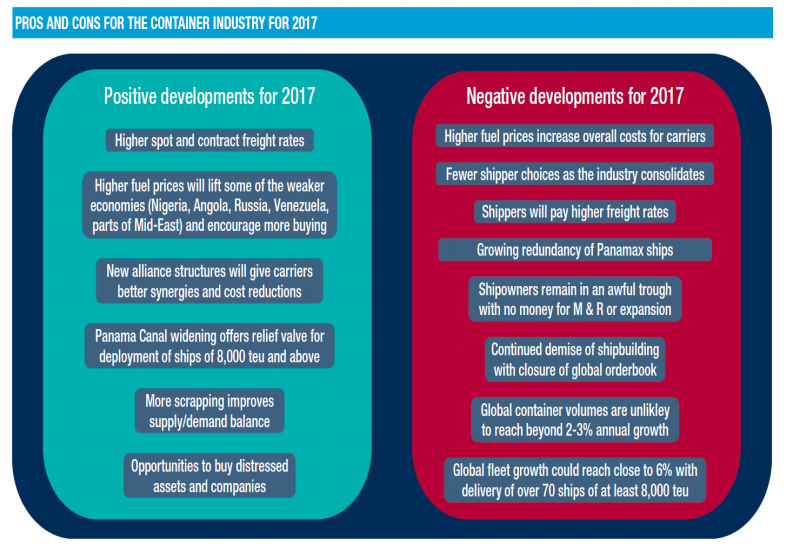3 Biggest Takeaways for Shippers from 2017 Projections
The holiday season is here. That means we’re approaching the end of 2016 and projections are being made about what 2017 will look like for the international shipping industry.
Drewry, the world’s leading independent maritime research company, released their over 100-page-long forecaster report, summing up the international shipping industry in 2016 while making projections for the industry in 2017. Universal Cargo colleagues Jerry Huang and Willy Hsu painstakingly went through the report to give an overview of what’s in store for the 2017 international shipping industry.
Not everything in that overview is likely to interest our readers, but there are many important points for shippers looking at the industry.
Possibly one of the best ways to get a feel for how things appear to be shaping for the 2017 international shipping industry is looking at a chart that lists what should be positive and negative developments for the industry in 2017.
Below is the list for you to view followed by my three biggest takeaways from it for shippers.

Positive & Negative Developments for International Shipping in 2017 shared by Huang & Hsu sourced from Drewry
1. Higher Freight Rates
This one made it onto both the positive and negative list.
At the very top of Drewry’s positive 2017 developments list shared by Huang and Hsu is higher spot and contract freight rates. Most shippers would think of this as a negative development, and you’ll notice Drewry also placed “shippers will pay higher freight rates” in the negative development list.
While I generally lean toward the shippers’ side when looking at the international shipping industry, I can’t help but think of higher freight rates in 2017 than 2016 as more of a positive than a negative.
Here’s why for the international shipping industry as a whole, higher freight rates are a good thing:
2016 saw record low freight rates. While lower freight rates decrease costs for shippers in the short run and make their bottom lines look better, over the long run it is a problem.
Unsustainably low freight rates is a major factor that played into the collapse of Hanjin Shipping. All the shippers who had cargo get caught up in the fallout of Hanjin’s bankruptcy would probably say they would have paid higher freight rates rather than have their cargo greatly delayed or fail to arrive at all (not to mention other fees and costs many shippers found themselves paying to get their Hanjin shipped cargo).
Freight rates have been pushed down to levels that make it extremely difficult for carriers to make a profit. Increased freight rates increase stability in the international shipping industry.
When making business deals, don’t you want stability? Knowing your cargo will arrive when it is supposed to and knowing extra costs won’t accrue in retrieving cargo that may already be extremely late is worth paying a little more in the first place.
Extremely low freight rates shrink carrier competition, and lead to greater costs in the long run. Speaking of which…
2. Fewer Shipper Choices as the Industry Consolidates
We’ve been talking about this for a long time in this blog. The carrier competition pool is shrinking in the international shipping industry.
In 2017, it is expected that mergers and acquisitions will continue the trend of shrinking the number of carriers for shippers to choose from.
It is certainly not out of the realm of possibility that another major carrier will go bankrupt like Hanjin Shipping did.
This is obviously a big negative for shippers.
Carriers have suffered losses in the billions of dollars as freight rates have dropped to levels impossible or nearly impossible for them to make a profit. Carriers largely brought this upon themselves by ordering ships, usually megaships, expanding capacity way beyond demand, and engaging in freight rate wars.
Now we go into 2017 with Maersk openly strategizing to acquire struggling carrier competition and Mitsui O.S.K. Lines Ltd. (MOL), Nippon Yusen Kabushiki Kaisha (NYK), and Kawasaki Kisen Kaisha, Ltd. (“K” Line)–Japan’s biggest three carriers–planning to merge.
As competition shrinks in the international shipping industry and carrier cooperation continues to increase, risk and rates rise for shippers.
3. Overcapacity Keeps Freight Rate Rise Reasonable
While freight rates are expected to increase in 2017, shippers shouldn’t expect those increases be to unreasonable levels.
This is because overcapacity will not come to an end in 2017.
Overcapacity is one of the biggest factors, if not the biggest factor, creating downward pressure on freight rates.
In Drewry’s negative column is the projection that global container volumes are unlikely to reach growth beyond 2-3%. While scrapping should increase and ship ordering should be non-existent, the global fleet could still grow close to 6% with the delivery of 70 ships of at least 8,000 TEU according to the last item in Drewry’s negative column.
This indicates a continued struggle with overcapacity in 2017, which should keep freight rates in check.
In fact, the overall conclusion that Huang and Hsu shared with Universal Cargo from Drewry’s research is that relief from a bottomed out market plagued by too many ships in light of a lower than expected global trade growth won’t come until 2019/2020.
The international shipping industry will still be a difficult one for carriers over the next couple years and if that relief really is to come in 2019 and 2020, it will require carriers to play their cards right in the meantime. And will they?
Shippers certainly do not need to run for the hills when it comes to 2017 international shipping rates but should be prepared for some increase. At the same time, keeping an eye on the health of the carriers shippers ship cargo through is a smart move.




